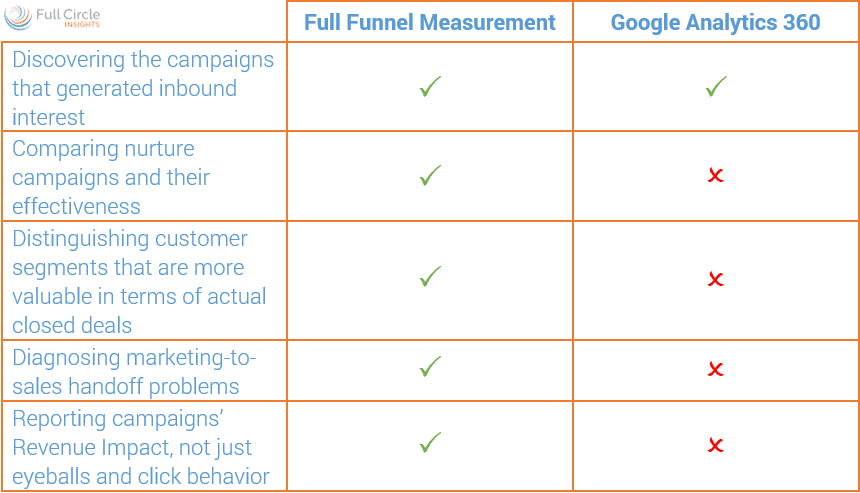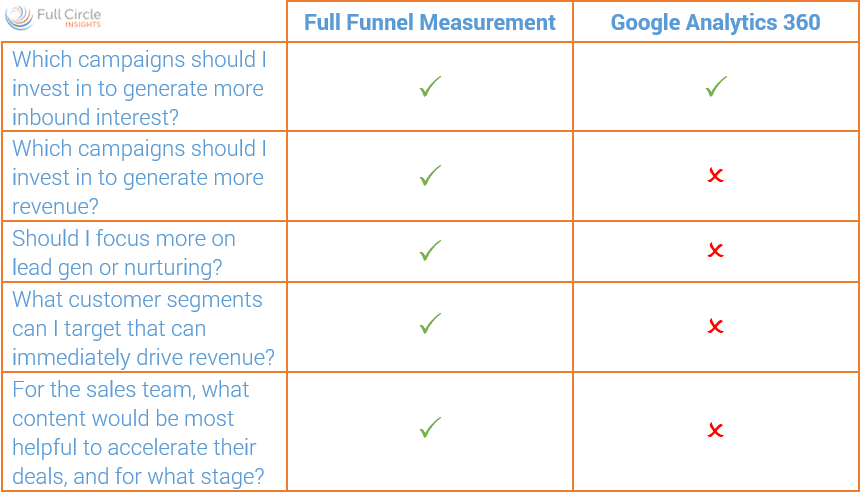As Marketing’s role evolves, we are seeing the focus shift from “reach-worthy” activities to revenue responsibility. Long gone are the days of big spending to attract eyeballs and page views. Marketing has become more accountable for revenue growth. This means we must take a focused approach with our marketing dollars so that our spend ends up paying dividends.
Where does Google Analytics 360 fit into this?
Google’s analytics product suite enables an integrated view of cross-channel marketing effectiveness that fits with today’s world of smartphones and third- and fourth-screen media consumption. It’s a clear value proposition to marketers. But, let’s also think about the complete marketing performance picture. For B2B marketers, comprehensive attribution includes active responses to a campaign, whether it’s a content download, a webinar registration, a booth visit, or a demo request (not just page views and clicks). This enables a marketer to more accurately follow a lead down the funnel and tie revenues to the marketing campaign. Only then can you apply sophisticated attribution models to find revenue impact and make fully informed marketing mix decisions. On the flipside, Google Analytics 360 focuses on attribution at the top of the funnel, and any attribution model applied would paint an incomplete picture of a marketing campaign’s impact on revenue.
Insights That Are Only Unlocked with a Full Funnel View
The goal of analytics is to derive insights that shape marketing decisions and ultimately drive revenue growth. What insights are you missing if you focus on Google Analytics 360’s product suite? For quick reference to a few examples, check out the comparison below.

Marketing Decisions That Require a Full Funnel View
Ultimately, these insights will help drive your marketing mix and prioritize your work products. Check out the table below and think about whether you’ve asked yourself these questions before.

The Takeaway
Don’t get us wrong: Google Analytics 360 is a great suite that includes almost mandatory analytics tools for the marketing team. But for many companies, especially B2B, Google’s tools provide only a few metrics that matter to the CEO, head of sales, and head of finance. Google Analytics 360 doesn’t provide the full solution when it comes to measuring various marketing campaigns that convert through the whole funnel. For attribution to be accurate, it must go beyond the pageview and integrate the middle and bottom of the funnel, which requires using a more comprehensive solution such as the Full Circle suite of Response Management and Campaign Influence.
Next Step: Using Multi-Touch Attribution to Compare Campaigns and Their Effectiveness
Now that you’re looking at your full marketing funnel and the impact all the way to the close of a deal, you can take a look at the individual campaign’s relative contribution to revenue compared to other campaigns. In aggregate, this allows you to understand which campaign types perform better, and, therefore, which campaign out of your emails, webinars, videos, social channels, ads, and blog posts (and the list goes on) you should pour more money into. Join me in my next blog post to learn more about various attribution models, including single-touch, multi-touch, contact-role weighted, and other custom model types. Click below and let Full Circle Insights help you discover and unlock the value from your marketing campaigns.
Picking the Right Attribution Model for You: Part 1, Single Touch Models >>




